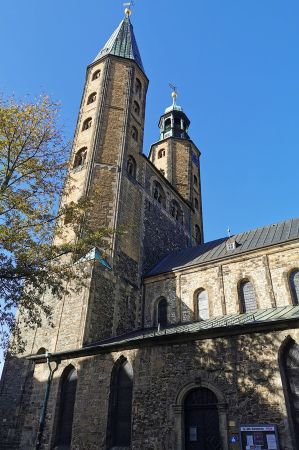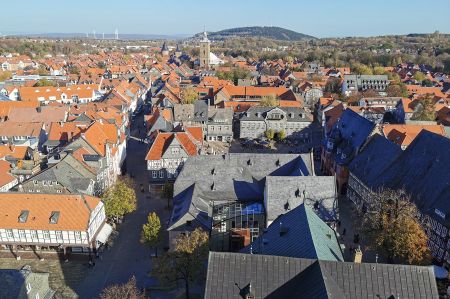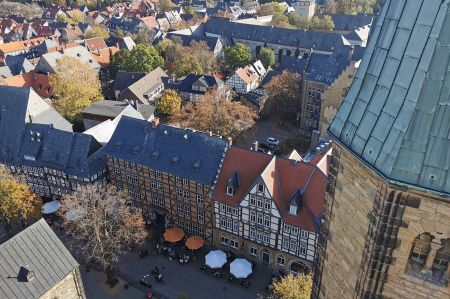Our first city tour in Goslar initially came to a surprising end at the market church of St. Cosmas and Damian, because no sooner had we climbed the 226 steps to the viewing platform than the bells caused a more than violent shock: deafening noise when you stand directly underneath!
Ascent to the north tower of the Marktkirche
 After our arrival in the old town, we had locked our bikes well and passed the first buildings in amazement when our path led almost automatically to the Marktkirche. The north tower was also open and thus invited us to climb up. An opportunity we didn't want to miss. The market church of St. Cosmas and Damian is the most imposing Evangelical-Lutheran church building in the centre of Goslar's old town and was first mentioned in a document in 1151. The Marktkirche is the town's council and main parish church and is named after Saints Cosmas and Damian (“ecclesia forensis”). The origins of today's church building go back to the 11th century, when a previous building must have existed. This was dedicated to St. Nicholas of Myra; it was probably a Romanesque, three-aisled pillar basilica with a transept and crossing.
After our arrival in the old town, we had locked our bikes well and passed the first buildings in amazement when our path led almost automatically to the Marktkirche. The north tower was also open and thus invited us to climb up. An opportunity we didn't want to miss. The market church of St. Cosmas and Damian is the most imposing Evangelical-Lutheran church building in the centre of Goslar's old town and was first mentioned in a document in 1151. The Marktkirche is the town's council and main parish church and is named after Saints Cosmas and Damian (“ecclesia forensis”). The origins of today's church building go back to the 11th century, when a previous building must have existed. This was dedicated to St. Nicholas of Myra; it was probably a Romanesque, three-aisled pillar basilica with a transept and crossing.
 Tickets were quickly bought and the climb up the wooden staircase could begin.
Tickets were quickly bought and the climb up the wooden staircase could begin.
As a professional, it was once again interesting to admire the stair construction of the past, even if the support points sometimes seemed very daring and no longer corresponded to today's structural standards.
However, the material and support points seemed to teach us otherwise, because we arrived safely at the top, see the attached pictures.
Tower room on the way up
Today's west wing of the market church, which towers up like a castle with its two towers, probably comes from this actually Romanesque church.
The two towers are almost the same height (north tower: 66 m, south tower 65.4 m). The north tower in its current form was built in 1593 after a fire (1589) as an "open lantern" with a French dome, which gives an excellent all-round view of Goslar.
In the north tower there is also the tower room, the accommodation for the fire station, which was common in the Middle Ages.
In the night of July 14/15, 1844, the church roof and both towers fell victim to a major fire, as did the bells. After reconstruction, the church was consecrated again in 1849.
Bell tower and open lantern at the top
The belfry is located in the middle part of the western part. There are three bells from 1848. The largest, named Johanna, weighs 6.8 tons, has a diameter of 2.21 m and is one of the largest bells in Lower Saxony. The second bell is named Christina, the third is named Paulina. An iron hour bell and a quarter hour bell hung in the open lantern of the north tower until 2016. In the meantime, they have been replaced by a historical bronze bell (hour) and a new cast bronze (quarter hour), which is also where our horror began. You are clearly warned when entering the stairwell, but when it starts, the quarter hour strike is enough to startle you.
Market Church Library on the north side
In a two-storey extension on the north side of the choir, which was completed in 1535, is the sacristy on the ground floor and a room on the first floor in which the books of the market church library were kept until 1841 or 1844 and then again between 1905 and 1969.
The beginnings of the market church library cannot be dated exactly, but they are before 1530.
Today the library has about 4,000 works with a focus on theological literature as well as a hymnal archive containing 1,200 copies.
The book collection is remarkable on the one hand for its rich stock of Reformation writings, which came to Goslar as a gift from the Halberstadt cleric Andreas Gronewalt around 1535, and on the other hand for its 115-volume incunabula.
A 1559 inventory of the holdings of the market church library included 282 volumes. A large part, estimated at 216, came from Gronewalt's possession. 31 volumes had a Goslar provenance and came from dissolved monasteries or were gifts from Goslar citizens. Since many narrow individual works were bound together in anthologies, there were multiple titles. Volumes have been lost over the centuries. Today the whereabouts of 52 volumes that existed in 1559 are unknown. At the same time, over the course of the centuries, books were repeatedly acquired or donated, such as the Both collection, which comprised around 1,000 volumes, in 1936.
The catalogue of the Latin works in the library, published in 1896 by the Goslar high school professor Uvo Hölscher, is available in print, as is the first complete catalogue of the library from 1911. It contains 1479 titles and parts of the hymnal collection. In the course of describing the historical book stocks in German libraries, the market church library was also described.
The library was kept until 1841 or 1844 and then again between 1905 and 1969 in a two-storey extension on the north side of the choir of the market church, completed in 1535, in which the sacristy is located at ground level and a protected, dry room for the books of the market church library on the first floor located.
From 1969, the volumes were stored under unfavourable conservation conditions in the community courtyard 8. Since December 2021, the historically most valuable part has been in a showroom in the Goslar cultural market place.
Please read as well:
With the e-bike from Camping Prahljust to Goslar
Walser costume - explanations of the tradition in Mittelberg


